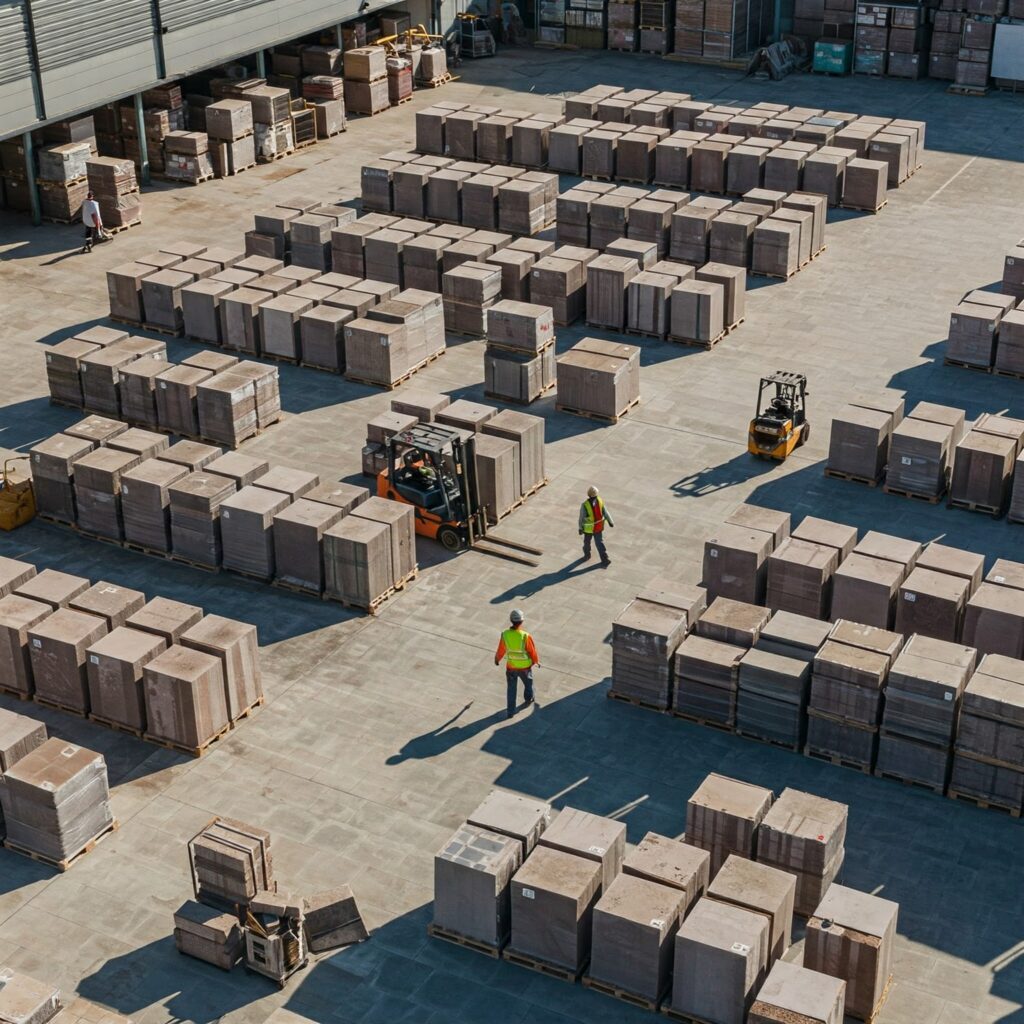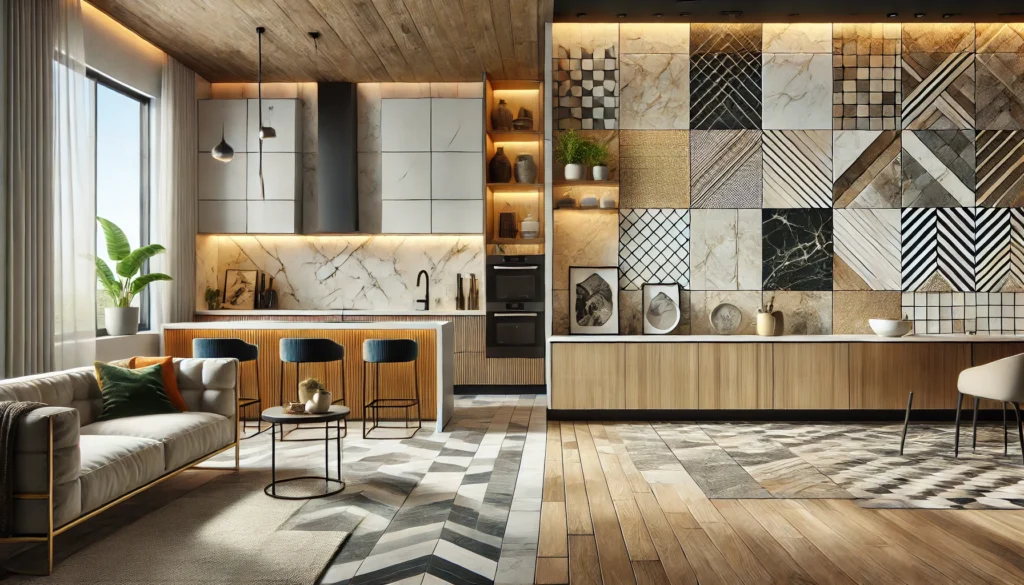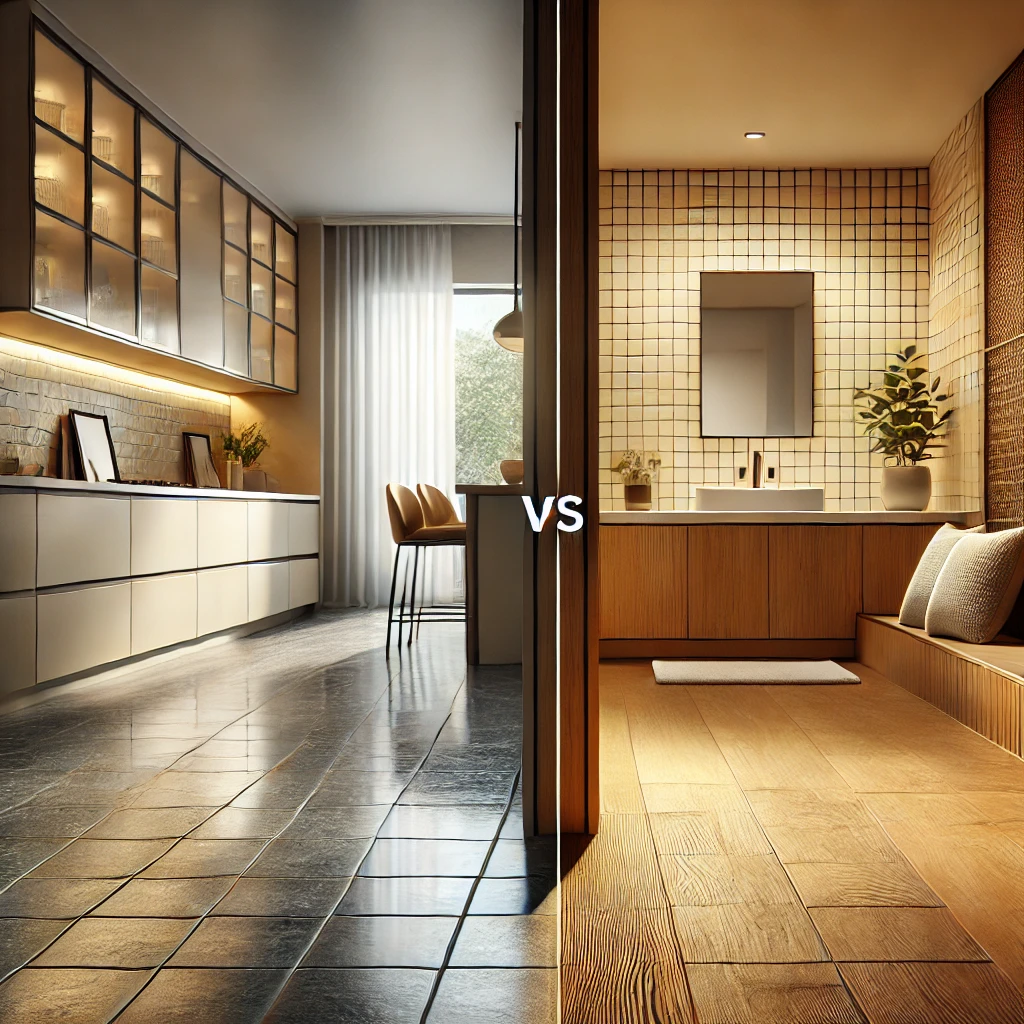Ever Felt Lost in the Endless Aisles of Tiles? You’re Not Alone!
Let’s be honest, stepping into a tile showroom or Browse online can feel like diving into an ocean of choices, right? Glossy, matte, ceramic, vitrified, big, small, patterned, plain… the options seem infinite! You’re trying to build or renovate your dream space – your home, your office – and the pressure is on to make the perfect choice. You want something beautiful, durable, within budget, and something that reflects your style. But where do you even begin when faced with so many brands, each claiming to be the best? It’s easy to feel overwhelmed, confused, and maybe even a little stressed. Does this sound familiar? You’re juggling aesthetics, practicality, and cost, all while trying to decipher technical jargon. It’s a common pain point, and you’re definitely not alone in feeling this way.
Why Choosing the Right Tile Company Matters More Than You Think
You might think, “Tiles are just tiles, right? How different can these companies be?” Well, think again! Choosing the right tile company is like choosing the right foundation for your house – it impacts everything that comes after. The company you select determines not just the look and feel of your floors and walls, but also:
- Quality & Durability: Will your tiles withstand daily wear and tear, resist stains, and last for years to come? Reputable companies invest heavily in R&D and quality control. Industry data often suggests that tiles from established players show significantly lower rates of chipping and fading over 5 years.
- Design & Innovation: Are you looking for classic elegance or the latest cutting-edge trends? Leading companies constantly innovate, offering diverse designs, textures, sizes, and finishes using technologies like digital printing and unique glazing techniques.
- Range of Products: Do they offer solutions for every need – floors, walls, bathrooms, kitchens, outdoor areas, commercial spaces? A comprehensive range simplifies your selection process.
- Consistency: Can you trust that the tiles you receive will match the sample you fell in love with? Established brands have stricter manufacturing processes ensuring colour and size consistency.
- After-Sales Support & Availability: What happens if you need a few extra tiles later, or if there’s an issue? Good companies have wider distribution networks and better customer support systems. Imagine the frustration of not being able to find replacement tiles for a small repair years down the line!
- Value for Money: While initial cost is a factor, the true value lies in longevity and performance. Sometimes, paying a slight premium upfront saves you money on replacements and headaches later.
Selecting a brand isn’t just about picking a pattern; it’s about investing in the long-term beauty, functionality, and value of your space.

What This Guide Will Cover
Consider this your ultimate roadmap to navigating the Indian tile landscape. We’re going to cut through the noise and provide clarity. In this comprehensive guide, we will:
- Explore the common challenges homeowners and builders face when choosing tiles.
- Reveal our curated list of the Top 20 Tile Companies in India, diving deep into what makes each one stand out.
- Explain the different types of tiles available and their best uses.
- Provide actionable tips for selecting the perfect tile based on your specific needs.
- Offer advanced insights into installation, maintenance, and sustainability.
- Answer some of the most frequently asked questions about tiles in India.
Ready to transform your tile-buying journey from stressful to successful? Let’s dive in!
The Problem: Navigating the Tile Maze
Choosing tiles feels like it should be fun – it’s about making your space beautiful! But the reality often involves navigating a complex maze filled with potential pitfalls. Let’s break down the common hurdles.
The Overwhelming Choices: So Many Tiles, So Little Time!
Walk into any large tile store, and you’re bombarded. Thousands of square feet showcasing endless variations. Ceramic, porcelain tiles, vitrified (what is vitrified, anyway?), double-charge, full-body, glazed, unglazed, polished, honed, rustic, large format, small format… it’s enough to make your head spin! Add to that dozens of brands, hundreds of designs within each brand, and the sheer volume of options can lead to decision paralysis. How do you compare apples to oranges when you’re not even sure what kind of fruit you need? You might spend hours, even days, looking, only to feel more confused than when you started. It’s like trying to choose a single grain of sand on a vast beach!
Decoding Quality: Separating the Best from the Rest
Every salesperson will tell you their tiles are “high quality Tiles.” But what does that actually mean? How can you, the buyer, truly assess the quality?
- Durability: Will the surface scratch easily? Will heavy furniture cause cracks?
- Water Absorption: Is it suitable for wet areas like bathrooms? Low water absorption is key, especially for porcelain and vitrified tiles (often less than 0.5%).
- Stain Resistance: Will spilled coffee or turmeric leave a permanent mark? Glazed tiles generally offer better stain resistance.
- Consistency: Are all the tiles in a batch the same size and colour? Minor variations can lead to major installation headaches and an uneven look.
- Certifications: Does the company adhere to BIS (Bureau of Indian Standards) or international quality standards?
Without technical knowledge, judging quality based purely on appearance is risky. You need reliable indicators, and often, the reputation and processes of the company behind the tile are the best proxy for quality. Relying solely on looks can be like buying a car based only on its paint colour – you might regret it later!
Budget Battles: Balancing Cost and Aesthetics
Ah, the budget. It’s the elephant in every renovation room. You’ve fallen in love with a stunning Italian-style marble-look tile, but the price tag makes your eyes water. Do you compromise on the look you adore, or stretch your budget thin? Finding that sweet spot between your desired aesthetic and your financial reality is a constant balancing act. Cheaper tiles might save you money upfront, but will they cost more in the long run due to faster wear or replacement needs? Conversely, are the most expensive tiles always the best, or are you paying a premium for branding alone? Market analysis suggests tile prices in India can range dramatically, from ₹30 per sq ft for basic ceramic to upwards of ₹500+ per sq ft for premium large-format vitrified slabs or imported designer tiles. Making an informed decision requires understanding what you’re paying for.
Trend Traps: Staying Stylish Without Regretting It Later
Remember those avocado green bathroom suites from the 70s? Or the fussy floral borders of the 90s? Tile trends, like fashion, come and go. While it’s tempting to go for the absolute latest style showcased in magazines, will you still love it in 5 or 10 years? Tiles are a semi-permanent fixture; replacing them is costly and disruptive. The challenge is to choose a design that feels current and reflects your personality but also has timeless appeal. How do you embrace modern aesthetics like large-format slabs, subtle textures, or wood-look tiles without choosing something that will look dated too quickly? It’s about finding a balance between contemporary style and lasting elegance.

The Solution: India’s Tile Titans – The Top 20 Revealed
Okay, enough about the challenges! Let’s get to the solution. We’ve waded through the options, considered the critical factors, and curated a list of the leading players who consistently deliver on quality, innovation, and reliability in the Indian market. These are the companies that have built reputations, invested in technology, and offer a wide spectrum of choices to meet diverse needs.
How We Selected These Top Companies
Our selection process wasn’t arbitrary. We considered several key factors to identify the true leaders in the Indian tile industry:
- Market Presence & Reach: How established is the company? Do they have a wide distribution network across India? Accessibility is key.
- Product Range & Diversity: Do they offer a comprehensive selection of tile types (ceramic, vitrified, porcelain), sizes, finishes, and designs for various applications?
- Innovation & Technology: Does the company invest in modern manufacturing techniques (like digital printing, advanced glazing, large slab technology) to offer cutting-edge products?
- Quality & Certifications: Does the company adhere to national (BIS) and international quality standards? Do they have a reputation for producing durable, consistent tiles? Customer reviews and industry reputation play a big role here.
- Brand Reputation & Trust: How long has the company been operating? What is their standing among architects, builders, and homeowners? Trustworthiness is paramount.
- Sustainability Practices: Is the company making efforts towards eco-friendly manufacturing and products? This is an increasingly important factor for conscious consumers.
Criteria for Selection (Recap)
- Quality: Adherence to standards, durability, consistency.
- Innovation: Use of technology, design leadership, new product development.
- Range: Variety of types, sizes, finishes for different applications.
- Reach: Distribution network, availability across India.
- Reputation: Brand image, customer trust, industry standing.
- (Bonus): Sustainability initiatives.
Disclaimer: This list is based on market presence, reputation, product range, and innovation as perceived in 2025. Market dynamics can change, and “best” can be subjective based on individual needs and priorities. We aim to provide a comprehensive overview of the major players. The order is not necessarily a strict ranking but rather a curated selection of top companies.

1. Kajaria Ceramics Ltd. – The Undisputed Market Leader
- A Glimpse into Kajaria’s Legacy: If there’s one name synonymous with tiles in India, it’s probably Kajaria. Founded in 1985, Kajaria Tiles has grown to become the largest manufacturer of ceramic and vitrified tiles in India and ranks among the top players globally. Their journey is a testament to consistent quality and adapting to market needs.
- What Makes Them Stand Out?: Kajaria boasts an enormous production capacity spread across multiple state-of-the-art manufacturing plants. They offer an unparalleled range – from affordable ceramic options to premium vitrified tiles (including polished, glazed, and full-body), large slabs under their ‘Ultima’ brand, and designer tiles. Their strength lies in their vast distribution network (thousands of dealers) ensuring availability even in smaller towns, and their constant innovation in design using advanced digital printing technology. They cater to almost every segment of the market.
- Ideal Applications & Target Audience: Homes, offices, commercial spaces, retail outlets, hospitality. Kajaria targets a broad audience, from budget-conscious homeowners to premium segment buyers and large project developers.
2. Somany Ceramics Ltd. – Innovation Meets Style
- A Glimpse into Somany’s Legacy: Another giant in the Indian tile industry, Somany Ceramics has been around since 1969. They have a rich history of innovation and are known for their strong focus on design and quality. They’ve consistently been one of the top choices for discerning customers.
- What Makes Them Stand Out?: Somany is recognized for its innovative product lines, including the patented VC Shield tiles (Vitrified Composite Shield) known for high abrasion resistance and durability. They also pioneered Veilcraft (VC) technology for unique finishes. Their portfolio includes ceramic, polished vitrified, glazed vitrified tiles, digital tiles, and large format slabs (‘Duragres Grand’). They emphasize stylish designs and have collaborations with international designers. Their focus on R&D keeps them at the forefront of tile technology.
- (H4) Ideal Applications & Target Audience: Residential projects (especially bathrooms and kitchens where design is key), commercial spaces, architects and interior designers seeking trendy yet durable options.
3. Asian Granito India Ltd. (AGL) – The Fast-Growing Powerhouse
- A Glimpse into AGL’s Legacy: Established in 2000, AGL has witnessed phenomenal growth, quickly becoming one of the largest ceramic tile manufacturers in India. They are known for their aggressive expansion and diversification.
- What Makes Them Stand Out?: AGL offers a vast product basket including ceramic floor and wall tiles, vitrified tiles (polished, glazed, double charge), outdoor tiles, composite marble, and quartz. They are particularly strong in the vitrified segment and have invested heavily in large-format tile production (‘Grestek MarbleX’). AGL focuses on bringing international trends to the Indian market at competitive price points. Their wide network of ‘AGL Tile World’ exclusive showrooms enhances their brand visibility.
- Ideal Applications & Target Audience: Residential and commercial projects, builders looking for bulk procurement, customers seeking trendy designs across various price points. They have a strong presence in the mid-to-premium segments.
4. Orient Bell Limited (OBL) – Trendsetters with a Digital Edge
- A Glimpse into OBL’s Legacy: With roots dating back to 1977, Orient Bell Limited (formerly Orient Ceramics & Industries Ltd.) has carved a niche for itself through design innovation and a customer-centric approach. They were among the pioneers of vitrified tiles in India.
- What Makes Them Stand Out?: OBL is renowned for its focus on digital printing technology, offering a plethora of designs, especially realistic wood-look, stone-look, and marble-look tiles. They have popular ranges like ‘Germ-Free Tiles’ (with antimicrobial properties), ‘Forever Tiles’ (high durability), and ‘Cool Tiles’ (solar reflective properties). OBL invests in understanding consumer needs and translating them into practical, stylish tile solutions. Their interactive website tools like ‘Quick Look’ and ‘TriaLook’ help customers visualize tiles in their space.
- Ideal Applications & Target Audience: Homeowners seeking stylish and functional tiles (especially for living rooms, bedrooms, bathrooms), architects valuing design innovation, health-conscious consumers (Germ-Free range), and those in warmer climates (Cool Tiles).
5. H. & R. Johnson (India) – A Legacy of Trust and Diversity
- A Glimpse into Johnson’s Legacy: Part of Prism Johnson Limited, H. & R. Johnson (India) is one of the oldest and most respected names in the industry, operating since 1958. They bring decades of experience and a strong reputation for quality.
- What Makes Them Stand Out?: Johnson offers arguably one of the most diverse portfolios, covering not just ceramic and vitrified tiles but also engineered marble and quartz (‘Johnson Marble & Quartz’), bath fittings (‘Johnson Bathrooms’), and construction chemicals. Their tile range includes Johnson Tiles, Johnson Porselano (vitrified), Johnson Marbonite (premium vitrified), and Johnson Endura (industrial/outdoor tiles). They are known for robust quality, specialized industrial tiling solutions, and a pan-India presence through ‘House of Johnson’ showrooms.
- Ideal Applications & Target Audience: Wide range – from residential homes to heavy-duty industrial flooring, commercial complexes, hospitals (due to specific product lines), and customers looking for a one-stop solution including bathware.
6. Nitco Ltd. – Premium Designs and Imported Flair
- A Glimpse into Nitco’s Legacy: Founded in 1953, Nitco has positioned itself as a premium brand, often associated with luxury and high-end design. They were initially focused on cement tiles and mosaics before venturing strongly into ceramic and vitrified tiles.
- What Makes Them Stand Out?: Nitco is known for its emphasis on aesthetics, importing some high-end tiles and collaborating with international designers. They offer ceramic, vitrified, full-body vitrified tiles, digital tiles, and are strong in marble (‘Naturoc’ engineered marble) and mosaics. Their ‘Magna’ Glazed Vitrified Slabs represent their push into large formats. Nitco often appeals to those seeking unique, statement-making surfaces. Their ‘Le Studio’ showrooms provide a premium retail experience.
- Ideal Applications & Target Audience: High-end residential projects, luxury apartments, premium commercial spaces, hotels, boutiques, architects and designers focused on luxury aesthetics.

7. Simpolo Vitrified Pvt. Ltd. – Morbi’s Vitrified Specialist
- A Glimpse into Simpolo’s Legacy: Hailing from Morbi, the ceramic hub of India, Simpolo started in 1977 and has become a leading manufacturer, particularly known for its expertise in vitrified tiles. They have a strong focus on technological advancement.
- What Makes Them Stand Out?: Simpolo is a pioneer in large format vitrified tiles (slabs) in India, using advanced Italian technology (SACMI Continua+). Their product range is heavily focused on high-quality vitrified tiles – polished, glazed, soluble salt, double charge, and full body. They offer sophisticated finishes and designs, often mimicking natural stone and marble flawlessly. Their ‘Simpolo Gallery’ showrooms showcase their premium offerings effectively. They are known for pushing the boundaries in size and finish.
- Ideal Applications & Target Audience: Modern homes, premium apartments, commercial spaces requiring large seamless floor areas, architects preferring large slab formats, export markets.
8. Varmora Granito Pvt. Ltd. – Quality and Variety from Gujarat
- A Glimpse into Varmora’s Legacy: Another key player from the Morbi cluster, Varmora Granito was established in 1994. They have built a reputation for producing a wide variety of quality tiles catering to different market segments.
- What Makes Them Stand Out?: Varmora offers a diverse product portfolio encompassing ceramic wall and floor tiles, polished and glazed vitrified tiles, large format slabs, and sanitaryware. They emphasize quality control and use modern manufacturing processes. They are known for offering trendy designs at competitive price points, making them a popular choice in both domestic and international markets. Their network is extensive, ensuring good availability.
- Ideal Applications & Target Audience: Residential projects (mid to premium), commercial spaces, builders, export markets. They offer a good balance of design, quality, and value.
9. Rak Ceramics India Pvt. Ltd. – Global Expertise, Local Presence
- A Glimpse into RAK’s Legacy: RAK Ceramics is a global giant headquartered in the UAE, with significant manufacturing operations in India (started around 2006). They bring international standards and design sensibilities to the Indian market.
- What Makes Them Stand Out?: RAK Ceramics is one of the largest ceramics brands in the world. In India, they offer a comprehensive range of vitrified tiles (polished, glazed), ceramic wall and floor tiles, and large format slabs (‘Maximus’). They are known for their adherence to stringent international quality standards, sophisticated designs often inspired by global trends, and focus on sustainability. They also have a strong portfolio in sanitaryware. Their global reputation lends them significant credibility.
- Ideal Applications & Target Audience: Premium residential projects, high-end commercial spaces, hospitality sector, airports, projects requiring adherence to international specifications, architects seeking globally recognized designs.
10. Bajaj Tiles – A Longstanding Name in Ceramics
- A Glimpse into Bajaj’s Legacy: While perhaps less aggressive in marketing compared to some giants, Bajaj Tiles (Bajaj Ceramics Limited) is a well-established name with a history dating back several decades. They have a solid reputation for reliable ceramic tiles.
- What Makes Them Stand Out?: Bajaj Tiles primarily focuses on ceramic floor and wall tiles, known for their durability and traditional designs. They cater significantly to the affordable and mid-range segments. While they may not always be at the forefront of cutting-edge vitrified trends, their strength lies in consistent quality in the ceramic category and a loyal customer base built over years. They offer dependable, functional tiling solutions.
- Ideal Applications & Target Audience: Budget-conscious residential projects, Tier-II and Tier-III cities, customers looking for reliable and affordable ceramic wall and floor tiles, government projects.
11. Cera Sanitaryware Ltd. – Beyond Bathrooms
- A Glimpse into Cera’s Legacy: Primarily known for sanitaryware and faucets, Cera Sanitaryware Ltd. (founded 1980) has successfully diversified into the tile segment, leveraging its strong brand recognition and distribution network.
- What Makes Them Stand Out?: Cera offers a curated range of ceramic wall and floor tiles, glazed and polished vitrified tiles, and digital tiles, often designed to complement their sanitaryware collections. Their strength lies in offering coordinated bathroom and kitchen solutions. They focus on contemporary designs and maintain good quality standards. Their established brand name in the bathroom space gives them an edge.
- Ideal Applications & Target Audience: Primarily residential bathrooms and kitchens, homeowners seeking coordinated solutions from a single brand, customers familiar and trusting the Cera brand for bathware.
12. Sunhearrt Ceramik – Rising Star from Morbi
- A Glimpse into Sunhearrt’s Legacy: Representing the dynamic newer generation of Morbi-based manufacturers, Sunhearrt Ceramik has rapidly gained prominence since its inception, focusing on large scale production and modern designs.
- What Makes Them Stand Out?: Sunhearrt specializes in glazed vitrified tiles (GVT) and polished glazed vitrified tiles (PGVT), leveraging state-of-the-art manufacturing technology. They offer a wide array of finishes and designs, including popular marble, wood, and stone effects, often in large formats. Their focus is on delivering trendy products with good quality at competitive price points, making them a significant player especially in the GVT/PGVT segment. They have a growing export market as well.
- Ideal Applications & Target Audience: Modern residential interiors (living rooms, bedrooms), commercial spaces, builders looking for stylish vitrified tiles, export markets.
13. Qutone Ceramic Pvt. Ltd. – Luxury and Grandeur
- A Glimpse into Qutone’s Legacy: Qutone has positioned itself firmly in the premium and luxury segment of the Indian tile market. They focus on innovation and bringing high-end, large-format tile solutions.
- What Makes Them Stand Out?: Qutone is known for its ‘imarble’ range – large format vitrified slabs that realistically mimic exotic marble patterns. They utilize advanced European technology for production, focusing on creating visually stunning and luxurious surfaces. Their emphasis is on grandeur, aesthetics, and product innovation, targeting the discerning customer. Their marketing often features celebrity endorsements, reinforcing their premium positioning.
- Ideal Applications & Target Audience: Luxury homes, high-end apartments, premium commercial establishments, hotels, lobbies, spaces where a statement of luxury is desired, architects catering to the elite segment.
14. Livon Ceramics – Focus on Digital Printing
- A Glimpse into Livon’s Legacy: Livon Ceramics is another significant player from Morbi, known for its strong focus on digital printing technology to create diverse and intricate tile designs.
- What Makes Them Stand Out?: Livon specializes in digitally printed ceramic wall tiles and glazed vitrified tiles (GVT/PGVT). Their strength lies in the sheer variety of designs they can produce, from floral and geometric patterns for walls to realistic wood and stone finishes for floors. They cater well to the mid-segment market that seeks decorative and stylish options without the premium price tag of some larger brands.
- Ideal Applications & Target Audience: Residential walls (especially bathrooms, kitchens, accent walls), mid-segment housing projects, customers looking for a wide variety of digital designs.
15. Italica Tiles – Ceramic Wall Tile Specialist
- A Glimpse into Italica’s Legacy: Italica Tiles has carved a niche primarily as a manufacturer of ceramic wall tiles, particularly for kitchens and bathrooms. They are known for consistent quality in this segment.
- What Makes Them Stand Out?: While many companies focus heavily on vitrified floor tiles, Italica maintains a strong presence in the wall tile market. They offer a wide range of sizes (like 12×18, 12×24 inches) and designs suitable for wet areas and kitchen backsplashes. They focus on delivering reliable quality and functional designs for wall applications.
- Ideal Applications & Target Audience: Bathroom walls, kitchen backsplashes, utility areas, residential projects where durable and aesthetically pleasing wall tiles are needed.

16. Motto Tiles (Accord Ceramics Pvt. Ltd.) – Growing Vitrified Player
- A Glimpse into Motto’s Legacy: Motto Tiles, under Accord Ceramics, is a prominent name from Morbi that has gained traction, especially in the vitrified tile segment. They focus on large-scale production and exports.
- What Makes Them Stand Out?: Motto offers a wide range of vitrified tiles, including soluble salt, double charge, glazed vitrified (GVT/PGVT), and full body tiles. They invest in technology to produce various finishes and sizes, catering to both domestic and international demands. They are known for competitive pricing in the vitrified category and have a substantial manufacturing capacity.
- Ideal Applications & Target Audience: Residential flooring, commercial projects, builders, significant focus on export markets.
17. Millennium Tiles – Double Charge Expertise
- A Glimpse into Millennium’s Legacy: Millennium Tiles is recognized in the industry, particularly for its expertise and production capacity in double charge vitrified tiles.
- What Makes Them Stand Out?: Double charge tiles are known for their durability, making them suitable for high-traffic areas. Millennium focuses on producing high-quality double charge tiles in various standard sizes (like 600x600mm, 800x800mm). While they also produce other types, their reputation is strongly linked to the double charge category, offering reliable solutions for demanding applications.
- Ideal Applications & Target Audience: Commercial spaces with high footfall (malls, offices, airports), residential areas requiring durable flooring, builders prioritizing longevity.
18. Sanford Vitrified Pvt. Ltd. – Focus on Polished Vitrified
- A Glimpse into Sanford’s Legacy: Sanford is another Morbi-based manufacturer that has made a mark, particularly in the polished vitrified tile (PGVT) and glazed vitrified tile (GVT) segments.
- What Makes Them Stand Out?: Sanford focuses on producing glossy, high-shine polished vitrified tiles that mimic the look of polished natural stone like marble. They utilize digital printing to achieve realistic patterns and offer these tiles in popular sizes. Their emphasis is on aesthetics and providing glossy surface solutions for modern interiors.
- Ideal Applications & Target Audience: Residential living areas, bedrooms, commercial spaces seeking a high-gloss, luxurious look, customers preferring polished finishes.
19. Lorenzo Vitrified Tiles (Production Likely by Other Morbi Players)
- A Glimpse into Lorenzo’s Presence: Lorenzo is often seen as a brand name, particularly prominent in retail and export markets, offering a range of vitrified tiles. It’s often associated with various manufacturers in Morbi who produce tiles under this brand.
- What Makes Them Stand Out?: The Lorenzo brand typically encompasses a wide variety of vitrified tiles – polished, glazed, double charge – often focusing on trendy designs and competitive pricing. Its strength lies in its brand recognition in certain markets and the sheer variety available under its umbrella, sourced from capable manufacturers.
- Ideal Applications & Target Audience: Mid-segment residential and commercial projects, export markets, retail customers looking for readily available designs. Note: Verifying the specific manufacturer behind a ‘Lorenzo’ batch might be needed for large projects.
20. Signature Tiles (Signature Ceramics Pvt. Ltd.) – Diverse Portfolio
- A Glimpse into Signature’s Legacy: Signature Tiles is known for offering a reasonably diverse portfolio catering to various needs within the ceramic and vitrified tile space.
- What Makes Them Stand Out?: Signature typically offers ceramic wall and floor tiles, along with different types of vitrified tiles (soluble salt, double charge, GVT/PGVT). They aim to provide a comprehensive range covering different price points and design preferences, acting as a reliable supplier for various project types.
- Ideal Applications & Target Audience: General residential and commercial applications, builders seeking a variety of options from a single source, Tier-II and Tier-III city markets.
Beyond the Brands: Making the Perfect Tile Choice
Knowing the top players is crucial, but it’s only half the battle. How do you select the right tile from their vast offerings for your specific needs? Let’s break down the key considerations.
Understanding Tile Types: Ceramic vs. Vitrified vs. Porcelain and More!
It’s easy to get lost in the terminology. Here’s a simple breakdown:
- Ceramic Tiles: Made from clay, sand, and water, fired at a lower temperature than vitrified/porcelain. Usually glazed.
- Pros: Affordable, wide variety of designs (especially for walls), easier to cut.
- Cons: Less dense, more porous (unless well-glazed), generally less durable than vitrified/porcelain, mainly suitable for walls or low-traffic floors. Think classic bathroom wall tiles.
- Vitrified Tiles: A type of ceramic tile made using a process (vitrification) involving hydraulic pressing and firing at very high temperatures. This makes them extremely strong, dense, and non-porous (water absorption typically <0.5%, sometimes even <0.1%).
- Pros: Highly durable, stain-resistant, frost-resistant, low water absorption, suitable for high traffic areas and outdoors.
- Cons: Can be more expensive, harder to cut.
- Sub-types:
- Soluble Salt: Basic vitrified, pattern is screen-printed using liquid colorant. Affordable, patterns are surface-level.
- Double Charge: Fuses two layers of pigment together (3-4mm top layer). More durable pattern than soluble salt. Good for medium-heavy traffic.
- Full Body: The pigment/design runs through the entire thickness of the tile. Most durable type; scratches are less visible. Ideal for very heavy traffic areas.
- Glazed Vitrified Tiles (GVT): Have a glaze layer applied before firing, allowing for intricate digital printing (designs, wood/stone looks).
- Polished Glazed Vitrified Tiles (PGVT): GVT tiles polished to a high gloss finish. Look luxurious but can be slippery when wet and may show scratches more easily than matte finishes.
- Porcelain Tiles: Technically a subset of vitrified tiles (in the Indian context, the terms are often used interchangeably, though internationally porcelain often implies <0.5% water absorption and specific clay composition). They are dense, hard, and suitable for heavy-duty applications. Often available as full-body or glazed.
- Other Types: You might also encounter Terracotta (rustic, porous), Quarry tiles (unglazed, durable), Mosaics (small tiles for decorative patterns), and large format slabs (very large tiles reducing grout lines).
Analogy: Think of Ceramic like a standard cake, Vitrified like a dense, rich fruitcake (more durable, less absorbent), and Full Body Vitrified like a fruitcake where the fruit runs all the way through (even if chipped, the inside looks similar).

Key Factors to Consider Before You Buy (Your Tile Selection Checklist!)
Before you fall in love with a design, ask these questions:
- [ ] Application Area: Where will the tile be used? (High traffic floor? Low traffic? Bathroom wall? Kitchen floor? Outdoor patio?) This determines the required durability and slip resistance.
- [ ] Traffic Level: How much footfall will the area receive? (High traffic = Vitrified, especially Double Charge or Full Body; Low traffic = Ceramic might suffice for floors).
- [ ] Water Exposure: Is it a wet area like a bathroom or kitchen? (Need low water absorption – Vitrified/Porcelain are best. Check the water absorption rate, ideally <0.5% for floors).
- [ ] Size & Format: Do you want small, intricate patterns or large, seamless looks? (Large formats (e.g., 800x800mm, 600x1200mm, larger slabs) make spaces look bigger and have fewer grout lines, but installation needs precision. Standard sizes like 600x600mm are common).
- [ ] Finish: What look and feel do you prefer?
- Glossy/Polished: Looks luxurious, reflects light, makes spaces brighter. Can be slippery when wet, may show scratches/smudges more. Best for walls or low-traffic, dry floors.
- Matte: Non-reflective, modern look, better slip resistance, hides smudges/minor scratches well. Great for floors, especially in wet areas.
- Satin/Lapatto: Semi-polished, subtle sheen. Good compromise between glossy and matte.
- Rustic/Textured: Provides excellent slip resistance, often mimics natural stone or wood. Ideal for outdoors, bathrooms, or creating specific design styles. Hides dirt well but might be slightly harder to clean.
- [ ] PEI Rating (for Glazed Tiles): Measures abrasion resistance (how quickly the glaze wears off). Ranges from PEI 1 (walls only) to PEI 5 (heavy commercial traffic). For residential floors, PEI 3 (light-moderate traffic) or PEI 4 (moderate-heavy traffic) is usually recommended. Ask the dealer for this rating! Data Insight: Many residential damages occur due to using wall-grade tiles (PEI 1-2) on floors.
- [ ] Slip Resistance (Coefficient of Friction – COF): Especially crucial for bathrooms, kitchens, and outdoor areas. Look for tiles specifically marked as anti-skid or with a higher COF rating (static COF >0.6 or dynamic COF ratings are increasingly used). Textured and matte finishes generally offer better slip resistance.
- [ ] Maintenance: How easy is the tile to clean? (Smoother glazes are generally easier. Textured tiles might require occasional scrubbing. Light colours might show dirt more easily than mid-tones or patterned tiles).
- [ ] Budget: Determine your square footage and set a realistic price per sq ft. Remember to factor in installation costs, adhesive, grout, and potential wastage (usually add 10-15% extra tiles).
- [ ] Grout Colour: Don’t forget this! Grout colour significantly impacts the final look. Contrasting grout highlights the tile shape; matching grout creates a more seamless appearance. Epoxy grout offers better stain and water resistance for wet areas but is more expensive.
Matching Tiles to Your Space: Room-by-Room Guide
- Living Room: High visibility area. Durability (PEI 3-4 Vitrified) is important. Large format tiles (800x800mm+) look elegant. Polished (PGVT) for luxury, Matte/Satin for a contemporary feel. Wood-look GVT is very popular.
- Kitchen: High traffic, prone to spills and stains. Need durable (PEI 3-4 Vitrified), stain-resistant, easy-to-clean tiles with good slip resistance (Matte or Textured finish recommended for floors). Ceramic is fine for backsplashes (walls).
- Bathroom: Wet area! Low water absorption (<0.5% Vitrified/Porcelain) is critical for floors. High slip resistance (Matte/Textured) is a MUST for safety. Ceramic is common for walls. Consider Germ-Free options.
- Bedroom: Lower traffic area. Comfort and aesthetics are key. Ceramic (PEI 2-3) might suffice for floors, but Vitrified offers more design options (wood look, fabric texture). Matte or Satin finishes feel cozier than high gloss.
- Outdoor/Patio/Balcony: Needs very durable (Full Body Vitrified or specialized outdoor tiles), frost-resistant, and high slip-resistant (Textured/Rustic finish) tiles. Consider colour fastness if exposed to direct sunlight. ‘Cool Tiles’ can be beneficial in hot climates.
Advanced Tips for Tile Success
Choosing the right tile brand and type is just the start. Ensuring a flawless finish and long-lasting beauty involves understanding installation and maintenance too.
Installation Insights: Getting it Right the First Time
Even the most expensive tiles can look bad if installed poorly. It’s estimated that up to 70% of tile failures are due to incorrect installation practices!
- Finding Reliable Installers: This is crucial. Ask for references, check online reviews, see photos of their previous work. Don’t just go for the cheapest quote. Experienced tile setters understand substrate preparation, proper adhesive application (using notched trowels for full coverage, no ‘spot bonding’!), level installation, and correct grouting techniques. Ask your tile dealer or architect for recommendations.
- Substrate Preparation: The surface beneath the tiles (floor or wall) must be clean, level, stable, and free from cracks or moisture. Skipping proper preparation is a recipe for disaster (lippage, cracked tiles).
- Using the Right Adhesive: Different tiles (ceramic vs large format vitrified) and substrates require specific adhesives. Using the wrong type can lead to bonding failure. Follow the manufacturer’s recommendations.
- Allowing for Expansion Joints: Especially important for large tiled areas. These joints prevent tiles from cracking or buckling due to structural movement or thermal expansion/contraction.
- Grouting Properly: Use the correct grout type (cementitious vs epoxy) for the application. Ensure grout joints are filled completely and cleaned properly before curing. Hasty grouting looks messy and can compromise water resistance.
Common Installation Mistakes to Avoid
- Uneven Surfaces (Lippage): Edges of adjacent tiles are at different heights. Caused by poor substrate leveling or improper setting. Use leveling systems for large format tiles.
- Hollow Sounding Tiles: Indicates poor adhesive coverage underneath. Tiles can become loose or crack easily. Ensure full bed troweling.
- Incorrect Grout Lines: Wavy or inconsistent grout lines spoil the look. Use spacers consistently.
- Starting in the Wrong Place: Layout planning is key to avoid awkward cuts at visible edges. Dry lay a few rows first to check the pattern and layout.
- Not Ordering Enough Tiles: Always order 10-15% extra for cuts, wastage, and potential future repairs. Trying to match a batch later can be impossible.
Long-Term Love: Tile Maintenance Made Easy
One of the best things about tiles is their low maintenance! But ‘low’ doesn’t mean ‘no’.
- Regular Cleaning: Sweep or vacuum regularly to remove grit that can scratch the surface (especially on polished tiles). Mop with water and a neutral pH tile cleaner. Avoid harsh acids or abrasive cleaners, which can damage the glaze or grout.
- Grout Care: Grout is porous and can stain or harbour mildew. Clean grout lines periodically with a specialized grout cleaner or a mixture of baking soda and water. Sealing grout (especially cementitious grout) annually can help repel stains and moisture. Epoxy grout is much more stain and water-resistant. Did you know? Studies show grout discoloration is one of the top complaints about tiled surfaces.
- Dealing with Stains: Tackle spills quickly. Most stains on glazed or vitrified tiles can be removed with appropriate cleaners. Refer to the manufacturer’s cleaning guidelines if unsure.
- Protecting High Gloss Tiles: Use doormats at entrances to trap dirt. Place felt pads under furniture legs to prevent scratches on polished surfaces.
The Sustainability Factor: Eco-Friendly Tiling Options
As environmental awareness grows, so does the demand for sustainable building materials. What makes a tile ‘eco-friendly’?
- Recycled Content: Some companies incorporate pre-consumer or post-consumer recycled material (like glass or industrial waste) into their tile body. Look for declarations of recycled content percentage.
- Resource Efficiency: Companies investing in modern kilns use less energy and water during manufacturing. Look for brands that highlight their water recycling programs or energy-efficient processes.
- Local Sourcing: Using locally manufactured tiles reduces transportation emissions compared to importing tiles from afar. Supporting Indian manufacturers contributes to this.
- Durability & Longevity: Tiles are inherently durable. Choosing high-quality tiles that last for decades reduces the need for replacement and the associated waste. This is perhaps the biggest sustainability aspect of tiles.
- Low VOCs: Tiles are generally very low in Volatile Organic Compounds (VOCs), contributing to better indoor air quality compared to some other flooring options like carpets. 1. wisecoatingspartners.com wisecoatingspartners.com
- ‘Cool Roof’ Tiles: Some companies (like Orientbell) offer tiles with high Solar Reflectance Index (SRI), which reflect sunlight and reduce heat absorption, potentially lowering building cooling costs.
Ask companies about their environmental certifications (like ISO 14001) or sustainability reports. Many leading Indian companies are increasingly focusing on these aspects.
Future Forward: Emerging Trends in the Indian Tile Industry
The tile world is constantly evolving. What’s next on the horizon?
- Even Larger Formats: Slabs are getting bigger (e.g., 1200x2400mm, 1600x3200mm), offering seamless, grout-minimal finishes that mimic natural stone slabs. Installation requires specialized skills and tools.
- Hyper-Realistic Designs: Digital printing technology continues to improve, creating incredibly realistic wood grains, marble veining, fabric textures, and concrete effects.
- Textural Innovation: Beyond visuals, tiles are incorporating subtle textures – brushed, honed, leathered, ribbed – adding tactile interest.
- Thin Tiles: Ultra-thin (3-6mm) but strong porcelain tiles are emerging, suitable for overlaying existing floors or walls, reducing renovation waste and time.
- Functional Tiles: Expect more tiles with integrated benefits like enhanced anti-bacterial properties, air purification capabilities, or even embedded heating elements (smart tiles).
- Outdoor Living Focus: With growing interest in balconies and patios, expect more sophisticated, high-performance outdoor tile ranges with excellent slip resistance and weather durability.
Conclusion: Tiling Your Way to a Beautiful Space
Whew! We’ve covered a lot of ground, haven’t we? From understanding the challenges of choosing tiles to exploring the Top 20 Tile Companies in India, diving into tile types, selection criteria, installation, maintenance, and even future trends.
Choosing the right tiles is a significant decision, impacting the aesthetics, functionality, and value of your space for years to come. It’s not just about picking a colour or pattern; it’s about selecting a brand known for quality, innovation, and reliability. Companies like Kajaria, Somany, AGL, Orientbell, H&R Johnson, Nitco, Simpolo, Varmora, RAK Ceramics, and the others on our list have earned their place through consistent performance and catering to diverse Indian needs.
Remember the key takeaways:
- Define Your Needs: Understand the application, traffic, and required performance before looking at designs.
- Research Brands: Look beyond just the tile; consider the company’s reputation, range, and quality commitments. Our list provides a strong starting point.
- Understand Tile Types: Know the difference between Ceramic, Vitrified (Double Charge, Full Body, GVT/PGVT), and Porcelain to match the tile to the job.
- Don’t Skimp on Installation: A good tile setter is worth their weight in gold. Proper installation ensures longevity and a flawless finish.
- Maintain Appropriately: Regular, gentle cleaning will keep your tiles looking beautiful for decades.
Ready to Start Your Tile Journey?
Feeling more confident now? We hope this comprehensive guide has demystified the process and empowered you to make informed decisions. The next step?
- Shortlist: Based on your needs and style, shortlist 3-5 brands from our list.
- Explore: Visit their websites, browse catalogues, or ideally, visit authorized dealer showrooms or company experience centres.
- Sample: Always get physical samples of your final choices to see them in your own lighting conditions.
- Plan: Factor in installation, wastage, and choose your installer wisely.
Choosing tiles can, and should be, an exciting part of creating your dream space. By arming yourself with knowledge and considering the factors we’ve discussed, you’re well on your way to selecting tiles that you’ll love for years to come. Happy tiling!
Frequently Asked Questions About Tile Companies in India
- Which tile company is absolutely the ‘best’ in India?
- There’s no single “best” for everyone, as needs vary. Kajaria is the largest market leader with the widest reach and range. Somany and Orientbell are strong on innovation and design. AGL offers vast variety at competitive points. H&R Johnson provides diversity including industrial solutions. Simpolo excels in large format vitrified. Your “best” depends on your specific priorities – budget, design preference, required durability, or specific features like anti-bacterial properties. It’s recommended to compare offerings from a few top contenders based on your project’s needs.
- Are tiles from Morbi (Gujarat) reliable? There are so many brands!
- Morbi is the ceramic hub of India, housing hundreds of manufacturers, including many top companies on our list (like Simpolo, Varmora, Sunhearrt, etc.). Quality varies significantly among Morbi manufacturers. While the leading brands based there maintain high standards and invest in technology, some smaller, unorganized players might cut corners. Stick to established, reputable brands from Morbi (many featured in our list) that have certifications (BIS, ISO), good market feedback, and proper distribution channels. Don’t just rely on the lowest price; verify the brand’s credentials.
- What’s the average price difference between ceramic and vitrified tiles from these top companies?
- Generally, basic ceramic tiles are the most affordable, often starting from ₹30-₹50 per sq ft. Vitrified tiles usually start higher, perhaps from ₹45-₹60 per sq ft for basic soluble salt or double charge, and can go up significantly for large formats, GVT/PGVT with intricate digital prints, full-body vitrified, or premium finishes, potentially reaching ₹150 – ₹500+ per sq ft. Prices vary greatly based on brand, size, finish, design complexity, and location. Always get quotes for specific tiles you are interested in. Remember that better durability often justifies a higher initial cost for flooring.
- How can I verify the quality of tiles before buying in bulk for a project?
- Besides choosing a reputable brand, you can:
- Check for BIS certification marks on the packaging.
- Ask for technical specifications: water absorption rate (<0.5% for vitrified floor tiles), PEI rating (for glazed tiles, aim for 3-4 for residential floors), thickness, and dimensional stability.
- Inspect samples carefully for surface uniformity, colour consistency, and edge finishing.
- For large projects, request a test certificate for the specific batch if possible.
- Check the batch numbers on all boxes upon delivery to ensure consistency. Minor shade variation between batches is common, so ensure your entire requirement comes from a single batch.
- Besides choosing a reputable brand, you can:
- Do these top Indian tile companies export their products?
- Yes, many of the leading Indian tile companies have a significant export footprint. Kajaria, Somany, AGL, Simpolo, Varmora, RAK Ceramics (being a global player itself), Sunhearrt, Motto, and several others export substantial volumes to countries across the Middle East, Africa, Europe, Asia, and even the Americas. The Indian tile industry is globally competitive, known for leveraging advanced technology (often Italian) to produce high-quality tiles at competitive prices, particularly in the vitrified segment.



